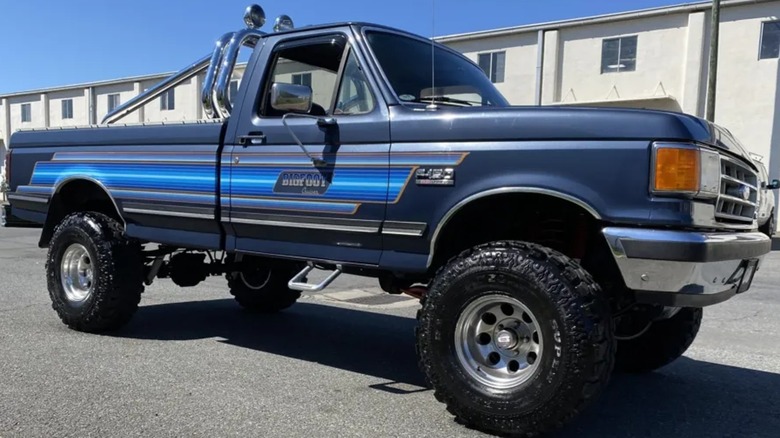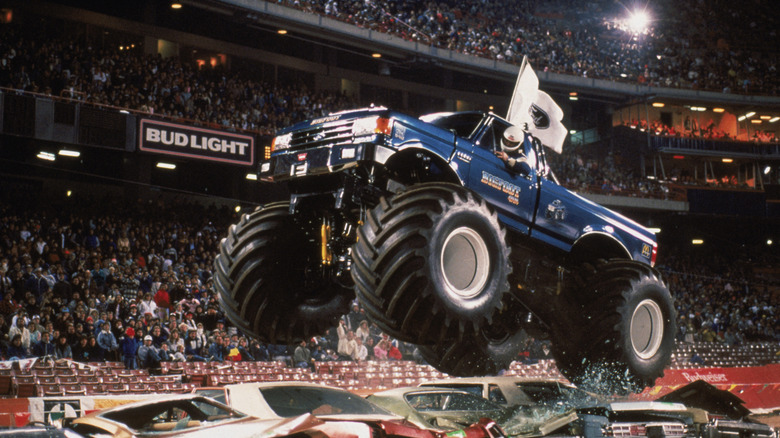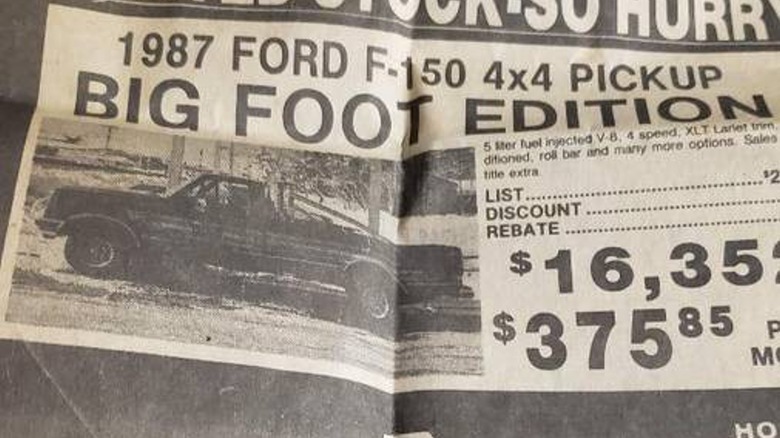The Bigfoot Cruiser: What Happened To The Monster Truck-Inspired Ford
As far back as the 1980s, onlookers would come from all around to see a souped-up truck rolling around on gigantic tires, crushing lesser vehicles beneath its proverbial heel and doing sick jumps off dirt ramps. Of course, you can't talk about monster trucks without remembering the granddaddy of them all, Bigfoot.
The original Bigfoot wasn't just an impressive Frankenstein of automotive engineering, it was a full-on cultural icon. Bigfoot was the original monster truck, bringing delight to the faces of the young and old and selling quite a bit of merchandise once the fad took off in earnest. Anyone looking to bank on the monster truck scene would do well to do so in Bigfoot's image, which is probably why Ford took a swing at such a thing in 1987 with the Bigfoot Cruiser. This special body package for the Ford F-150, F-250, F-350, and Ford Ranger would add 33-inch wheels, several extra inches on the suspension lift, a winch-equipped fender, and heavy-duty shocks. Topped off a pair of Bigfoot logos emblazoned on the sides and the original's signature blue and gold decals, and you had a mini-monster truck right in your own driveway.
The package was inspired by Bigfoot's origins as a Ford truck
Even before the Bigfoot Cruiser was released to the public, the mere concept of it seemed like a match made in heaven. After all, the original Bigfoot was constructed from a 1974 Ford F-250 pickup truck by hobby tinkerer Bob Chandler. This humble pursuit-turned automotive mad science eventually gave birth to the behemoth vehicle we know and love today, and the original Bigfoot team is still tinkering with the truck's design in new and interesting ways.
While Ford was doing just fine for itself in the 1980s with its F-series line of pickup trucks, the sheer success of Bigfoot and monster truck products, combined with the vehicle's origins as a Ford truck, sparked a fairly obvious point of commercial connection. While Ford couldn't sell people duplicates of an entire monster truck, it could give riders a rough approximation of what it's like to drive a souped-up beast of a vehicle, not to mention cash in on the Bigfoot branding in the process.
The package was retired due to recalls and safety concerns
While the Bigfoot Cruiser was absolutely awesome on paper, in practice, turning trucks into little monsters brought with it a handful of serious problems. For one thing, the package didn't undergo proper crash and safety testing. This became problematic when it was discovered that the larger wheels were rubbing up against the fender and brake lines of the vehicle, causing wear and damage. The lug nuts fastening the wheels to the body also had a tendency to come loose when put under stress, which could lead to sudden destabilization. Perhaps the most alarming concerns were reports that attempting to use the cruise control on the vehicle could spark a fire.
Ford issued a recall on the Bigfoot Cruiser package just a few years into its life, and with only around 300 units estimated to have been sold, the package wasn't exactly selling gangbusters anyway. This is why, in 1990, Ford decided to quietly end the sale of the Bigfoot Cruiser package.
The Bigfoot Cruiser has become a rare collectible car
Following the recalls and out of concern for potential lawsuits, Ford bought back a large number of Bigfoot Cruisers and stripped them for parts. It's not clear how many of the original Bigfoot Cruisers this buyback accounts for. Additionally, the package wasn't only sold pre-assembled – collectors believe as many as 600 Ford trucks were sent in for aftermarket installations of the Bigfoot package, which may not have been returned in the recall or buyback.
Because of this confusing process, nobody is completely sure how many authentic Bigfoot Cruisers are still floating around. This, in turn, has made the vehicle a highly sought-after collector's item. Whenever one goes up for sale, it's usually for at least $10,000, though pristine models have sold at auction for as much as $70,000.
The Bigfoot Cruiser was a very cool idea, and given Bigfoot's origins as a Ford vehicle, the connection made sense on paper. Unfortunately, it wasn't such a great idea to put a monster truck in the hands of an average driver, even if it was a paired-down one. This may be why, in 1994, Ford opted for a much simpler Bigfoot collab, merely adding a nifty logo and Bigfoot-inspired paint job.



